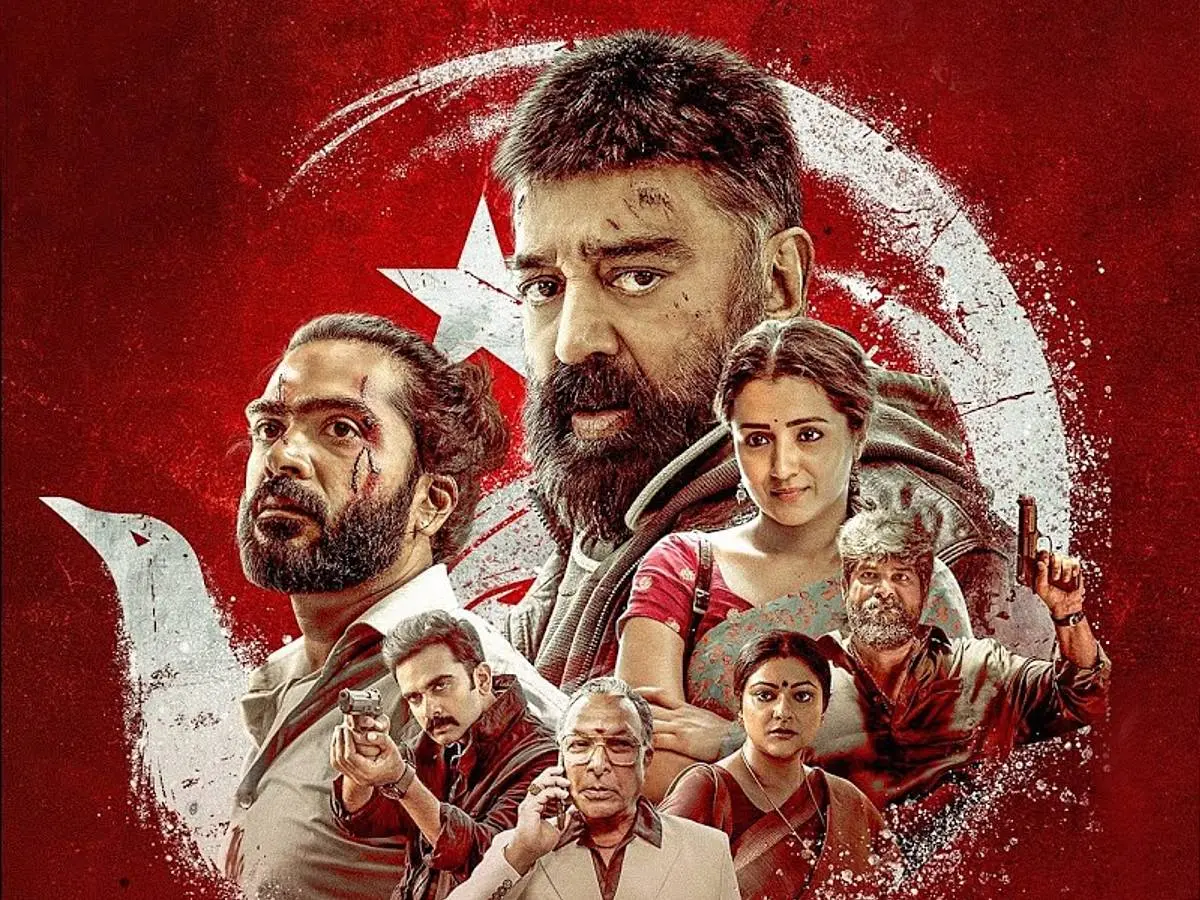
What’s it about?
Rangaraya Shakti Raju (Kamal Haasan) is a gangster based in Delhi. During a shootout with the police, he escapes by using a child named Amar as a shield. Amar’s father is killed in the encounter, and his sister, Chandra, goes missing. Shakti Raju raises Amar as his own and eventually grooms him into his trusted aide.
Amar (Simbu) not only earns Shakti Raju’s trust but also expands their criminal empire by striking a deal with a politician, which sparks suspicion in Shakti Raju’s mind. Despite being devoted to his wife, Lakshmi (Abhirami), Shakti Raju also has an affair with a dancer, Indrani (Trisha).
While on a trip to Nepal, Shakti Raju is ambushed by his own men, and is pushed off a hill. Presumed dead, Amar takes over the criminal operations and even claims Indrani as his own. But two years later, Shakti Raju returns and begins his ruthless quest for revenge. Will everything go as planned for Shakti Raju? Is Amar really bad guy?
Analysis
“Thug Life,” the much-anticipated collaboration between Kamal Haasan and director Mani Ratnam after their iconic film Nayakudu, is a revenge drama that explores themes of loyalty, betrayal, and mortality. The story idea reportedly originated with Kamal Haasan, who initially conceived it as a film titled “Amar Hai.” Mani Ratnam later developed it into a full script, with both credited as writers.
However, the film begins to lose footing right from the start. Kamal Haasan’s character introduces himself as a gangster—or more specifically, a ‘Yakuza’—a term rooted in Japanese crime culture that feels out of place in the Indian context. His look and the attempt to adopt that aesthetic fall flat, failing to create the desired impact. The film then shifts into a lengthy flashback, which spans almost two hours.
The flashback forms the core of the narrative, chronicling how Kamal Haasan’s character saves a boy named Amar during a shootout, raises him like a brother, and is ultimately betrayed by him. Within this stretched narrative, only a handful of moments stand out: the early scenes between Kamal Haasan and Trisha (who plays his mistress), a temple sequence where Kamal apologizes to Amar (Simbu), and an emotionally poignant scene with Abhirami at the Thiruchendur beach.
The story jumps from one location to another—Delhi, Goa, Nepal, Nellore, and Thiruchendur—but these shifts feel superficial, adding little to the emotional or narrative depth. The frequent change in setting fails to enrich the plot.
The core problem with “Thug Life” is that nearly every idea and sequence—beyond the basic plot—feels overly familiar, evoking a constant sense of déjà vu. We’ve seen variations of this story play out in countless gangster dramas before, and this film brings nothing new to the genre. The gangster setup deosn’t look real at all, either. What initially appears to be an intriguing dynamic between Kamal Haasan, Trisha, and Simbu eventually devolves into something flimsy and emotionally hollow. Even the dialogues, especially those referring to women as trophies for men, come across as forced and tone-deaf, further weakening the impact of the narrative.
There are several illogical sequences as well. Right after the interval, Kamal Haasan’s character is shot twice and falls off a snowy cliff—yet somehow manages to walk several kilometres and even survive an avalanche. After recovering, he goes on to train in martial arts. These developments feel completely out of place and stretch believability.
Coming to performances, Kamal Haasan shoulders the film with his seasoned screen presence. Playing the role of Rangaraya Shakti Raju, an aging gangster grappling with betrayal, Kamal brings gravitas. The use of de-aging technology in flashback portions is quite effective as well. His authority in intense scenes and subtle vulnerability in emotional moments elevate the otherwise inconsistent writing.
Simbu, unfortunately, is let down by a character arc that feels undercooked. Amar is written without a clear moral compass. Still, Simbu gives it his all, is sincere in his efforts. Trisha, cast as Indrani, is criminally underutilized. What begins as a potentially layered role soon devolves into a caricature. In contrast, Abhirami gets one of the film’s few well-rounded characters. As Lakshmi, Shakti Raju’s wife, she brings dignity and emotional heft. Her scenes in the second half are some of the film’s most affecting moments.
Veteran actors like Nasser, Mahesh Manjrekar, and Tanikella Bharani play routinely. Ashok Selvan feels miscast and disconnected from the narrative. Aishwarya Lekshmi’s role makes sense only in the climax.
AR Rahman’s music doesn’t work either. The only song worked in the film is “Acha Vanne Puvvu.” The true hero of the film undoubtedly is cinematographer Ravi K Chandran. The visual palette and the frames are superb. Many episodes look so beautiful. Production design and costume design are impressive.
Bottom-line: “Thug Life” is a bore. While it starts off with some promise, the film gradually loses momentum and descends into a tedious experience. The entire second half is muddled and lacks coherence. In the end, “Thug Life” turns out to be a misfire from the legendary duo of Kamal Haasan and Mani Ratnam.
Rating: 1.75/5
By Jalapathy Gudelli
Movie: Thug Life
Cast:Kamal Haasan, Silambarasan TR, Trisha, Abhirami, Ashok Selvan, Aishwarya Lekshmi, Joju George, Nasser, and others
Written by: Kamal Haasan and Mani Ratnam
Music: AR Rahman
DOP: Ravi K. Chandran
Editor: Sreekar Prasad
Production Designer: Sharmishta Roy
Fights: Anbariv
Produced by: Kamal Haasan, Mani Ratnam, R Mahendran, Siva Ananth
Directed by:Mani Ratnam
Release Date:June 5, 2025






